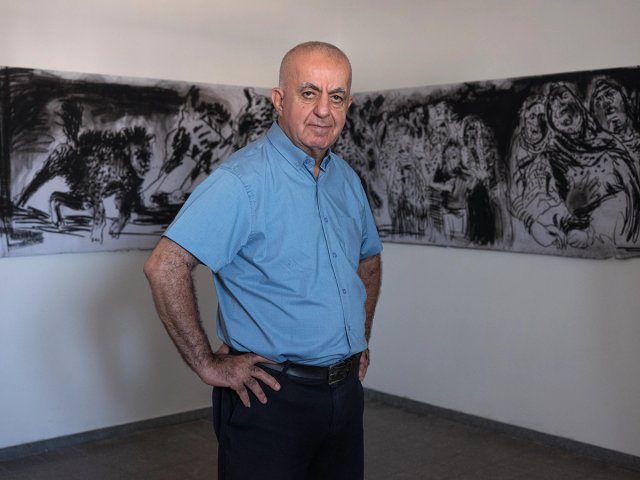o Guillermo Kuitca paints surrealistic schemes, transfiguring maps or diagrammatic plans of apartments that float in abstract space. His new exhibition, “Castle to castle”, takes its cue from architecture. “Painting produces an enormous referential arbitrariness, while architecture does just the opposite,” says the thirty-seven year-old Argentinian. While Kuitca is currently showing new work at Sperone Westwater; a retrospective of his paintings can also be seen at the Centro de Arte Helio Oiticica in Rio di Janeiro, Brazil.
o Kara Hammond’s small-scale paintings evoke a large-scale sense of post-industrial desolation. Working in oils on wood and copper, Hammond focuses on parking lots, highway sound walls, factory smoke stacks, and similar scenes of moody emptiness. The exhibition of new work at Joseph Rickards Gallery will be the second for the artist, who is from North Carolina, but currently lives in Brooklyn.
o Sandro Chia, one of the three “Big C’s” of contemporary Italian art, along with Francesco Clemente and Enzo Cucchi, returns to the New York scene this month with a show of new works at the Tony Shafrazi Gallery. Chia’s latest offerings focus on single figures engaged in unheroic, yet happy activities, and bear titles such as “Goodbye”, “Conversation”, and “Resting”, which match their simple gestures. This upbeat suite of paintings was shown recently at the Frederic R. Weisman Museum of Art in California.
o Not seen solo in New York since a retrospective at P.S. 1 in 1988, Michelangelo Pistoletto will be at the Max Protetch gallery this month. The artist’s earlier objects from the 60s fuelled the Arte Povera movement and the new sculptures, according to Mr Protetch, will draw on architectural elements such as windows and doors. Entitled, “Does God exist? Yes, I do!”, the show juxtaposes the modest Pistoletto’s works from the 70s and 80s with his most recent oeuvre. Pistoletto lives in Turin and Vienna, where he is a professor at the Akademie der Bildenden Künste.
o The vast expanses of the large Chelsea galleries cry out for grand sculptural installations to fill them. Tony Smith’s “Stinger”, the summer show at Paula Cooper, satisfies that desire. Over six-feet-high and thirty-two-feet-square, Stinger was last presented in a full-size plywood mockup at the Museum of Modern Art’s exhibition, “The art of the real”, in 1968. Now it has been recast in sleek black steel. Viewers can walk through a single opening into an enclosure at the centre of the square-shaped piece.
o The Holly Solomon Gallery is still recovering from an unusual show arising from unfortunate circumstances. Most of the photographs by Nick Waplington, a London artist the gallery exhibited in March, were either damaged or lost by Federal Express. In a Duchampian vein, Waplington incorporated the wreckage into his exhibition, displaying a mangled FedEx box and letters from the company along with the pictures that survived. “Well, he wasn’t happy about it, but he worked with it”, said a gallery spokesman. This month, Solomon exhibits the work of Virgil Marti for the first time. The thirty-eight year-old Philadelphia-based artist makes wallpaper and room installations. His show includes floor-to-ceiling images of beer cans in one room and a fantasy interior in the other. Marti uses intensified colour that evokes interior design aesthetic of the late 1960s and early 1970s.
o Did Andy Warhol really die? It is hard to believe because he seems more productive than ever. Gagosian’s latest offering from the copious Warhol archives is “Philip’s skull”, a series of 1985 paintings the silver-wigged necrophile made from CAT-scans of the skull of Greek tycoon and art collector Philip Niarchos. The show brings together two favourite Warholian themes: wealth and morbidity.
o Sean Landers uses the press release for his new exhibition at Andrea Rosen as an opportunity to bare his soul. “During these last ten years I’ve experienced great highs and mind-boggling lows,” writes the sly, self-indulgent slacker-artist. Bad reviews of his last show left him “totally depressed and a bit disillusioned. I realised that you really can hurt me with your words and after all, I am mortal.” Now Landers has returned with a new batch of his amusing, if slightly oppressively amateurish, Surreal paintings, inspired by Magritte’s postwar work.
o Ellsworth Kelly gets star treatment this month with simultaneous exhibitions at Matthew Marks Gallery and Mitchell-Innes & Nash. Matthew Marks presents drawings from 1960 to 1962, that show Kelly’s scientific inquiry into natural forms delineated with his signature crisp line. “Ellsworth Kelly: spectrums, 1953-72,” at Mitchell-Innes & Nash, examines Kelly’s experiments with spectral colour, in drawings and paintings.
o Lance Fung, gallerist and representative of the estate of the artist Gordon Matta-Clark, has put together an exhibition that is both a historical show of Matta-Clark’s work and a tribute to him by his celebrated friends. Matta-Clark was known for his sawn-apart buildings, his conceptual ideas, and for launching Food, the first artist-run restaurant in SoHo. “Infraform”, a cut-apart wall piece from the early 1970s, will be replicated by the artist’s friend and frequent collaborator, Richard Nonas. Artists Robert Barry and Sol LeWitt will create drawings on the surfaces of “Infraform,” and Fung will also exhibit a wall drawing by the late conceptual artist Douglas Huebler.
o Smash! Crash! Boom! Any explosive sounds you hear at PaceWildenstein this month might be linked to the Julian Schnabel plate paintings. Collectors have purportedly been woken up in the middle of the night to the sound of cascading porcelain, courtesy of the Armani-clad superstar. This month, visitors to the uptown and downtown galleries will encounter a two-part retrospective of the Neo-Expressionist’s 1980-97 experiments with broken crockery.
Originally appeared in The Art Newspaper as 'Did Andy Warhol really die?'


